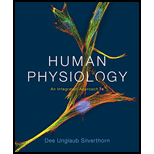
EBK HUMAN PHYSIOLOGY
7th Edition
ISBN: 9780133983401
Author: Silverthorn
Publisher: YUZU
expand_more
expand_more
format_list_bulleted
Question
Chapter 4, Problem 5RQ
Summary Introduction
Introduction: The process, in which one or more molecules react with each other to form new molecules, is known as a reaction. The rate of the reactions can be increased by the enzymes that act as biocatalyst and participate in reactions to lower down its activation energy.
Expert Solution & Answer
Want to see the full answer?
Check out a sample textbook solution
Students have asked these similar questions
Biology Question
✓ Details
Draw a protein that is embedded in a membrane (a transmembrane protein), label the lipid bilayer and the protein. Identify the areas of
the lipid bilayer that are hydrophobic and hydrophilic.
Draw a membrane with two transporters: a proton pump transporter that uses ATP to generate a proton gradient, and a second
transporter that moves glucose by secondary active transport (cartoon-like is ok). It will be important to show protons moving in the
correct direction, and that the transporter that is powered by secondary active transport is logically related to the proton pump.
drawing chemical structure of ATP. please draw in and label whats asked. Thank you.
Chapter 4 Solutions
EBK HUMAN PHYSIOLOGY
Ch. 4 - Which biomolecules always include nitrogen in...Ch. 4 - Prob. 2CCCh. 4 - What is the difference between potential energy...Ch. 4 - Prob. 4CCCh. 4 - Prob. 5CCCh. 4 - Prob. 6CCCh. 4 - Prob. 7CCCh. 4 - Prob. 8CCCh. 4 - Prob. 9CCCh. 4 - Prob. 10CC
Ch. 4 - Prob. 11CCCh. 4 - Name five ways in which cells regulate the...Ch. 4 - Prob. 13CCCh. 4 - Prob. 14CCCh. 4 - Match each component on the left to the...Ch. 4 - Prob. 16CCCh. 4 - How is the separation of mitochondria into two...Ch. 4 - Prob. 18CCCh. 4 - Prob. 19CCCh. 4 - Prob. 20CCCh. 4 - What does the name RNA polymerase tell you about...Ch. 4 - Explain in one or two sentences the relationship...Ch. 4 - Prob. 23CCCh. 4 - List three general types of posttranslational...Ch. 4 - Prob. 25CCCh. 4 - List the three basic forms of work and give a...Ch. 4 - Prob. 2RQCh. 4 - Prob. 3RQCh. 4 - Prob. 4RQCh. 4 - Prob. 5RQCh. 4 - Prob. 6RQCh. 4 - Match each definition in the left column with the...Ch. 4 - Prob. 8RQCh. 4 - Organic molecules that must be present in order...Ch. 4 - In an oxidation-reduction reaction, in which...Ch. 4 - Prob. 11RQCh. 4 - Prob. 12RQCh. 4 - Prob. 13RQCh. 4 - Metabolic regulation in which the last product of...Ch. 4 - Prob. 15RQCh. 4 - Prob. 16RQCh. 4 - Create maps using the following terms.Ch. 4 - Prob. 18RQCh. 4 - Prob. 19RQCh. 4 - Prob. 20RQCh. 4 - Prob. 21RQCh. 4 - Briefly describe the processes of transcription...Ch. 4 - On what molecule does the anticodon appear?...Ch. 4 - Is the energy of ATPs phosphate bond an example of...Ch. 4 - Prob. 25RQCh. 4 - Prob. 26RQCh. 4 - Prob. 27RQCh. 4 - Prob. 28RQ
Knowledge Booster
Similar questions
- Outline the negative feedback loop that allows us to maintain a healthy water concentration in our blood. You may use diagram if you wisharrow_forwardGive examples of fat soluble and non-fat soluble hormonesarrow_forwardJust click view full document and register so you can see the whole document. how do i access this. following from the previous question; https://www.bartleby.com/questions-and-answers/hi-hi-with-this-unit-assessment-psy4406-tp4-report-assessment-material-case-stydu-ms-alecia-moore.-o/5e09906a-5101-4297-a8f7-49449b0bb5a7. on Google this image comes up and i have signed/ payed for the service and unable to access the full document. are you able to copy and past to this response. please see the screenshot from google page. unfortunality its not allowing me attch the image can you please show me the mathmetic calculation/ workout for the reult sectionarrow_forward
- Skryf n kortkuns van die Egyptians pyramids vertel ñ story. Maximum 500 woordearrow_forward1.)What cross will result in half homozygous dominant offspring and half heterozygous offspring? 2.) What cross will result in all heterozygous offspring?arrow_forward1.Steroids like testosterone and estrogen are nonpolar and large (~18 carbons). Steroids diffuse through membranes without transporters. Compare and contrast the remaining substances and circle the three substances that can diffuse through a membrane the fastest, without a transporter. Put a square around the other substance that can also diffuse through a membrane (1000x slower but also without a transporter). Molecule Steroid H+ CO₂ Glucose (C6H12O6) H₂O Na+ N₂ Size (Small/Big) Big Nonpolar/Polar/ Nonpolar lonizedarrow_forward
- what are the answer from the bookarrow_forwardwhat is lung cancer why plants removes liquid water intead water vapoursarrow_forward*Example 2: Tracing the path of an autosomal dominant trait Trait: Neurofibromatosis Forms of the trait: The dominant form is neurofibromatosis, caused by the production of an abnormal form of the protein neurofibromin. Affected individuals show spots of abnormal skin pigmentation and non-cancerous tumors that can interfere with the nervous system and cause blindness. Some tumors can convert to a cancerous form. i The recessive form is a normal protein - in other words, no neurofibromatosis.moovi A typical pedigree for a family that carries neurofibromatosis is shown below. Note that carriers are not indicated with half-colored shapes in this chart. Use the letter "N" to indicate the dominant neurofibromatosis allele, and the letter "n" for the normal allele. Nn nn nn 2 nn Nn A 3 N-arrow_forward
arrow_back_ios
SEE MORE QUESTIONS
arrow_forward_ios
Recommended textbooks for you
 Principles Of Radiographic Imaging: An Art And A ...Health & NutritionISBN:9781337711067Author:Richard R. Carlton, Arlene M. Adler, Vesna BalacPublisher:Cengage Learning
Principles Of Radiographic Imaging: An Art And A ...Health & NutritionISBN:9781337711067Author:Richard R. Carlton, Arlene M. Adler, Vesna BalacPublisher:Cengage Learning- Essentials of Pharmacology for Health ProfessionsNursingISBN:9781305441620Author:WOODROWPublisher:Cengage



Principles Of Radiographic Imaging: An Art And A ...
Health & Nutrition
ISBN:9781337711067
Author:Richard R. Carlton, Arlene M. Adler, Vesna Balac
Publisher:Cengage Learning


Essentials of Pharmacology for Health Professions
Nursing
ISBN:9781305441620
Author:WOODROW
Publisher:Cengage
